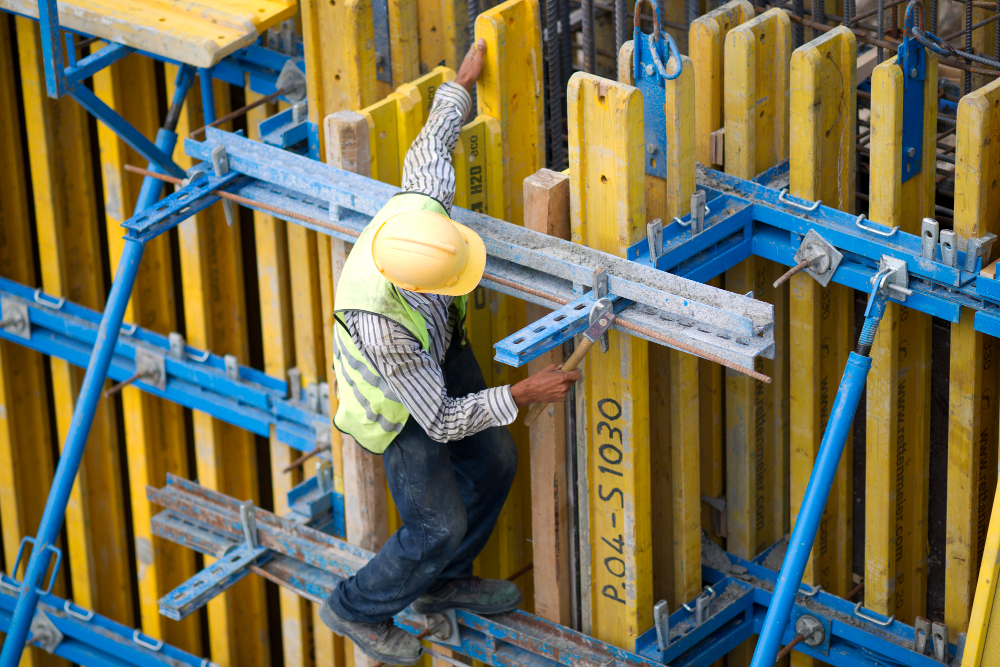Structural steel has long provided the backbone for numerous buildings, bridges, and infrastructure projects. It has long been a foundation in the construction industry.
What is the importance of structural steel? What are its advantages and applications? How does it compare to other construction materials? The experts at Lion Barns aim to answer all these questions and more in this article.
Read on.
The Role of Structural Steel in Construction
Structural steel is primarily composed of iron and carbon, often enhanced with other alloying elements such as manganese, chromium, and nickel to significantly improve its mechanical properties. These additional elements increase the material’s strength, ductility, and resistance to corrosion, making it highly suitable for demanding construction environments. The careful balance of these components results in a material that can endure significant loads and stresses, ensuring the stability and safety of large structures.
One of the defining characteristics of structural steel is its exceptional load-bearing capacity, which allows it to support the immense weight of buildings, bridges, and industrial facilities. Its ability to handle both tensile and compressive forces makes it ideal for creating structural frameworks that can withstand natural forces like wind, earthquakes, and heavy snow. Additionally, structural steel’s strength enables the construction of taller and more expansive structures without the need for excessively bulky support elements, optimizing both space and material use.
The widespread adoption of structural steel in construction is also driven by its adaptability and design flexibility. Engineers and architects can shape steel into various forms and sizes, facilitating the creation of innovative and complex designs. Whether used for sleek, modern skyscrapers or intricate bridge designs, steel’s versatility supports creative architectural expression while ensuring the durability and integrity of the structure. This combination of strength, adaptability, and aesthetic potential has solidified structural steel’s essential role in modern construction projects.
Advantages of Structural Steel
1. Exceptional Strength-to-Weight Ratio
Structural steel offers an impressive strength-to-weight ratio, allowing for the construction of taller, more robust structures without excessive bulk. This property is crucial in high-rise buildings, bridges, and large industrial facilities where strength and stability are paramount.
2. Durability and Longevity
Steel structures can endure harsh environmental conditions, including extreme weather, seismic activity, and heavy loads. Its resistance to pests, rot, and fire (when properly treated) contributes to a longer lifespan and reduced maintenance costs.
3. Design Flexibility
Structural steel can be fabricated into a wide variety of shapes and sizes, offering architects and engineers greater creative freedom. Complex, modern designs, such as curved facades and expansive open spaces, are achievable thanks to steel’s adaptability.
4. Sustainability
Steel is one of the most recycled materials globally, and structural steel is no exception. It can be repurposed without losing its strength, reducing the need for new raw materials and lowering environmental impact. This recyclability aligns with sustainable construction practices.
5. Cost-Effectiveness
Although steel can have a higher upfront cost compared to some materials, its long-term benefits—including durability, low maintenance, and faster construction times—often result in cost savings over the building’s lifecycle.
Applications of Structural Steel in Construction
1. Commercial Buildings
Structural steel is widely used in commercial construction for skyscrapers, office buildings, and shopping malls. Its strength allows for large, open floor plans and towering structures that define urban skylines.
2. Industrial Facilities
Factories, warehouses, and power plants benefit from steel’s ability to support heavy equipment and withstand industrial stresses. Steel’s durability makes it ideal for facilities exposed to harsh conditions.
3. Infrastructure Projects
Bridges, tunnels, and railways rely heavily on structural steel due to its load-bearing capacity and resistance to dynamic forces. Its use in infrastructure ensures safety and longevity for critical transportation networks.
4. Residential Buildings
While less common, structural steel is increasingly used in residential construction, especially in multi-family housing and luxury homes. Its strength allows for expansive living spaces and modern architectural designs.
5. Temporary Structures
Steel’s ease of assembly and disassembly makes it suitable for temporary structures like exhibition halls, event stages, and emergency shelters. Its reusability further adds to its appeal for such applications.
Comparison with Other Construction Materials
1. Structural Steel vs. Concrete
Concrete is another widely used construction material, known for its compressive strength. However, structural steel surpasses concrete in tensile strength, making it better suited for structures requiring flexibility and high load-bearing capacity. Steel structures are also lighter, reducing foundation loads and construction costs.
2. Structural Steel vs. Wood
Wood is commonly used in residential construction due to its availability and ease of use. However, steel outperforms wood in strength, durability, and resistance to fire and pests. Steel is preferred for larger or more complex projects requiring greater structural integrity.
3. Structural Steel vs. Masonry
Masonry materials like brick and stone offer excellent thermal mass but are limited in their ability to span large spaces without support. Structural steel allows for wider spans and open designs, offering more design freedom and functional space.
Sustainability and Environmental Impact
Structural steel supports sustainable construction practices through its exceptional recyclability and inherent energy efficiency. Unlike many other building materials, steel can be recycled multiple times without losing its structural integrity or quality. This closed-loop recycling process significantly reduces the need for raw material extraction, conserves natural resources, and lowers the carbon footprint associated with producing new steel. Modern steel production methods have also evolved to become more environmentally friendly, utilizing energy-efficient technologies and cleaner manufacturing processes that reduce greenhouse gas emissions and energy consumption.
Moreover, steel structures can be designed with sustainability in mind by integrating energy-efficient features. Advanced insulation materials, reflective roofing systems, and natural ventilation designs can be easily incorporated into steel frameworks, helping to reduce heating and cooling demands in buildings. This adaptability allows architects and engineers to create structures that not only meet but exceed energy efficiency standards, contributing to lower operational costs and a reduced environmental impact over the building’s lifespan. Steel’s compatibility with green technologies, such as solar panels and green roofs, further enhances its role in sustainable design.
Using structural steel also minimizes construction waste, as its components are often prefabricated in controlled factory environments to exact specifications. This precision manufacturing reduces material excess and errors, leading to cleaner construction sites and less environmental disruption. Additionally, at the end of a building’s life cycle, steel components can be dismantled and recycled rather than discarded, significantly reducing landfill waste. This cradle-to-cradle lifecycle ensures that structural steel remains one of the most sustainable choices for construction, aligning with global efforts to reduce waste and promote responsible resource management.
Challenges and Considerations
1. Corrosion Risk
Without proper treatment, steel can be prone to corrosion, especially in humid or coastal environments. Protective coatings, galvanization, and regular maintenance are essential to mitigate this risk.
2. Fire Resistance
While steel is non-combustible, it loses strength at high temperatures. Fireproofing measures, such as applying fire-resistant coatings or encasing steel components in protective materials, are necessary to maintain structural integrity during fires.
3. Cost Fluctuations
Steel prices can be volatile due to market demand and raw material costs. Project budgets must account for potential price changes during construction.
4. Skilled Labor Requirements
Fabricating and assembling steel structures requires specialized skills and equipment. Access to experienced labor and proper training is critical to ensure safe and efficient construction.
Future of Structural Steel in Construction
Structural steel supports sustainable construction practices through its exceptional recyclability and inherent energy efficiency. Unlike many other building materials, steel can be recycled multiple times without losing its structural integrity or quality. This closed-loop recycling process significantly reduces the need for raw material extraction, conserves natural resources, and lowers the carbon footprint associated with producing new steel. Modern steel production methods have also evolved to become more environmentally friendly, utilizing energy-efficient technologies and cleaner manufacturing processes that reduce greenhouse gas emissions and energy consumption.
Moreover, steel structures can be designed with sustainability in mind by integrating energy-efficient features. Advanced insulation materials, reflective roofing systems, and natural ventilation designs can be easily incorporated into steel frameworks, helping to reduce heating and cooling demands in buildings. This adaptability allows architects and engineers to create structures that not only meet but exceed energy efficiency standards, contributing to lower operational costs and a reduced environmental impact over the building’s lifespan. Steel’s compatibility with green technologies, such as solar panels and green roofs, further enhances its role in sustainable design.
Using structural steel also minimizes construction waste, as its components are often prefabricated in controlled factory environments to exact specifications. This precision manufacturing reduces material excess and errors, leading to cleaner construction sites and less environmental disruption. Additionally, at the end of a building’s life cycle, steel components can be dismantled and recycled rather than discarded, significantly reducing landfill waste. This cradle-to-cradle lifecycle ensures that structural steel remains one of the most sustainable choices for construction, aligning with global efforts to reduce waste and promote responsible resource management.
Conclusion
Structural steel is undeniably vital to modern construction. Its combination of strength, durability, design flexibility, and sustainability makes it an ideal material for a wide range of projects, from towering skyscrapers to intricate bridges. While challenges like corrosion and fire resistance require careful management, the long-term benefits of steel far outweigh these concerns.

